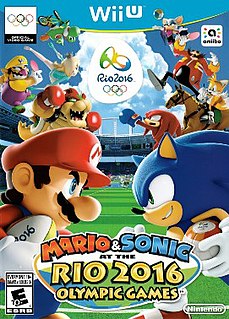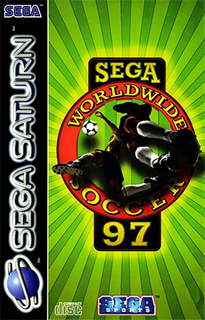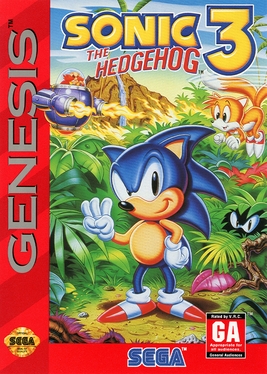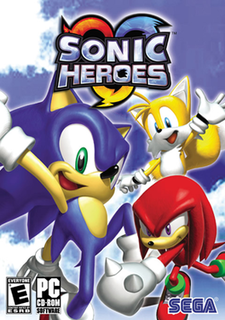 W
WDaytona USA: Championship Circuit Edition or Daytona USA: Circuit Edition in Japan, is a racing game by Sega, specifically designed for the Sega Saturn. Released in 1996, it is a reworked and extended version of the original Daytona USA, and was developed by the same team that oversaw the Saturn port of Sega Rally Championship, by using a modified version of the Sega Saturn engine of Sega Rally Championship.
 W
WDengeki Bunko: Fighting Climax is a 2D arcade fighting game developed by Ecole Software and French Bread and published by Sega. The game celebrates the 20th anniversary of ASCII Media Works' Dengeki Bunko imprint, featuring various characters from light novels published under the imprint. The game was first released in Japanese arcades in March 2014, and later released on PlayStation 3 and PlayStation Vita on November 13, 2014. The console version was released in North America and Europe in October 2015. The game's theme song is "Belief" by Mami Kawada.
 W
WFormula One World Championship: Beyond the Limit, released in Japan as Heavenly Symphony: Formula One World Championship 1993, is a racing game developed and published by Sega, with production assistance from by Fuji Television, and released for the Sega CD in 1994. As the name implies, the game places the player in the seat of a Formula One car complete with multiple teams and opponents, and all the licensed tracks of the series.
 W
WMario & Sonic at the London 2012 Olympic Games is a 2011 sports and party game developed by Sega Japan. As with the previous two Mario & Sonic titles, it was published by Nintendo in Japan and by Sega in all other regions. The game is officially licensed by the International Olympic Committee (IOC) through exclusive licensee International Sports Multimedia. It is the third installment in the Mario & Sonic series after the commercial success of its predecessors and is an official video game of the 2012 Summer Olympic Games. The game was released on the Wii on November 15, 2011 in North America, November 17, 2011 in Australia, November 18, 2011 in Europe, and December 8, 2011 in Japan. It was also released for the Nintendo 3DS in February 2012. The game is the first, and the only one to come in a yellow keep case instead of a standard white case, similar to how New Super Mario Bros. Wii was the only game to have a red keep case. The Wii version, like the original 2007 Olympic Games version, does not support the Balance Board; the 2009 Winter Olympics version does.
 W
WMario & Sonic at the Rio 2016 Olympic Games is a crossover sports and party game in the Mario & Sonic at the Olympic Games series, released for the Nintendo 3DS in February 2016 in Japan, March 2016 in North America, and in April 2016 for Europe and Australia, and for the Wii U worldwide in June 2016. The game is officially licensed by the International Olympic Committee, as have the other games in the series. It was developed by Sega, with assistance from Arzest and Spike Chunsoft, and published by Nintendo. It is the fifth title in the Mario & Sonic at the Olympic Games series. The game is a collection of Olympic sports themed mini-games featuring characters from the Mario series and the Sonic the Hedgehog series.
 W
WMetal Head is a 3D mecha simulation shooter video game developed and published by Sega, and released in 1995 for the Genesis/Mega Drive's 32X add-on, allowing for fully texture-mapped polygons.
 W
WNASCAR Arcade, initially known as NASCAR Rubbin' Racing outside North America, is a 2000 racing arcade game developed by Sega Rosso and released by Sega. It was produced at the suggestion of producer Kenji Arai, and the soundtrack was produced by Jun Senoue. The game is based on NASCAR, and carries an official license with permission from Electronic Arts, which permitted Sega to develop the game as a coin-op only title.
 W
WSega Rally 2006 is an arcade oriented racing game developed and published by Sega for PlayStation 2. It is the third installment in the decade running Sega Rally series, and it was released in Japan on January 12, 2006. This version is the first non-arcade-version–based Sega Rally. Its action footage was used in World Rally Championship.
 W
WSega Worldwide Soccer 97 is a football video game by Sega released for the Sega Saturn in 1996. It was followed by three more titles: Sega Worldwide Soccer '98 still on the 32-bit console and two editions of Sega Worldwide Soccer 2000, the second being Sega Worldwide Soccer 2000 Euro Edition for the Dreamcast.
 W
WShadow the Hedgehog is a 2005 platform game developed by Sega Studios USA, the former United States division of Sonic Team, and published by Sega. It is a spin-off from the Sonic the Hedgehog series and follows Shadow the Hedgehog, a creation of Doctor Eggman's grandfather, Prof. Gerald Robotnik, as he attempts to learn about his past while suffering from amnesia. Shadow the Hedgehog introduces third-person shooter elements and nonlinear gameplay to the Sonic franchise. To defeat enemies, Shadow can use various weapons and special attacks, and most levels have three possible missions that the player may choose to complete. The missions completed determine the game's plot and subsequently playable levels.
 W
WSonic the Hedgehog 3 is a 1994 platform game developed and published by Sega. It is part of the Sonic the Hedgehog series and follows Sonic the Hedgehog 2 (1992). After Doctor Robotnik's spaceship, the Death Egg, crash-lands on a mysterious floating island, Sonic and Tails attempt to retrieve the Chaos Emeralds to stop it from relaunching. Sonic 3 introduces Knuckles the Echidna, the island guardian, who lays traps for Sonic and Tails. Gameplay is similar to previous entries, with players traversing side-scrolling levels at high speeds while collecting rings and defeating enemies.
 W
WSonic 3D Blast, known in Europe and Japan as Sonic 3D: Flickies' Island, is a 1996 platform game in the Sonic the Hedgehog series for the Sega Genesis and Sega Saturn. As Sonic the Hedgehog, the player embarks on a journey to save the Flickies, birds enslaved by Doctor Robotnik. The player must guide Sonic through a series of themed levels to collect Flickies and defeat Robotnik. Though it retains game mechanics from prior Sonic games, Sonic 3D Blast is differentiated by its isometric perspective, with pre-rendered 3D models converted into sprites.
Sonic Adventure is a 1998 platform game for Sega's Dreamcast and the first main Sonic the Hedgehog game to feature 3D gameplay. The story follows Sonic the Hedgehog, Miles "Tails" Prower, Knuckles the Echidna, Amy Rose, Big the Cat, and E-102 Gamma in their quests to collect the seven Chaos Emeralds and stop series antagonist Doctor Robotnik from unleashing Chaos, an ancient evil. Controlling one of the six characters—each with their own special abilities—players explore a series of themed levels to progress through the story. Sonic Adventure retains many elements from prior Sonic games, such as power-ups and the ring-based health system. Outside the main game, players can play minigames like racing and interact with Chao, a virtual pet.
 W
WSonic Adventure 2 is a 2001 platform game developed by Sonic Team USA and published by Sega. It was the final Sonic the Hedgehog game for the Dreamcast after Sega discontinued the console. It features two good-vs-evil stories: Sonic the Hedgehog, Miles "Tails" Prower and Knuckles the Echidna attempt to save the world, while Shadow the Hedgehog, Doctor Eggman and Rouge the Bat attempt to conquer it. The stories are divided into three gameplay styles: fast-paced platforming for Sonic and Shadow, multi-directional shooting for Tails and Eggman, and action-exploration for Knuckles and Rouge.
 W
WSonic Adventure 2 is a 2001 platform game developed by Sonic Team USA and published by Sega. It was the final Sonic the Hedgehog game for the Dreamcast after Sega discontinued the console. It features two good-vs-evil stories: Sonic the Hedgehog, Miles "Tails" Prower and Knuckles the Echidna attempt to save the world, while Shadow the Hedgehog, Doctor Eggman and Rouge the Bat attempt to conquer it. The stories are divided into three gameplay styles: fast-paced platforming for Sonic and Shadow, multi-directional shooting for Tails and Eggman, and action-exploration for Knuckles and Rouge.
 W
WSonic & Knuckles is a 1994 platform game developed and published by Sega. It is part of the Sonic the Hedgehog series and the sequel to Sonic the Hedgehog 3 (1994). Players control Sonic the Hedgehog and Knuckles the Echidna in their quests to save Angel Island; Sonic tries to prevent Doctor Robotnik from relaunching his orbital weapon, the Death Egg, while Knuckles scuffles with Robotnik's minion, EggRobo. The game takes place across six levels in which the player collects rings and fights bosses.
 W
WSonic and the Black Knight is a 2009 platform game developed by Sonic Team and published by Sega as part of the Sonic the Hedgehog series. The game was released on the Wii as the second entry in the Sonic Storybook series, following Sonic and the Secret Rings (2007). Set in the world of King Arthur, the game combines Sonic's trademark speed with a new sword fighting system, utilizing the Wii Remote's motion-sensing functionality.
 W
WSonic Generations is a 2011 platform game developed by Sonic Team and published by Sega for the PlayStation 3, Xbox 360, Nintendo 3DS, and Microsoft Windows. Produced in commemoration of the 20th anniversary of the Sonic the Hedgehog series, the game follows Sonic and his sidekick Tails as they form an alliance with their past selves. It features two gameplay styles: "Classic", which plays from a side-scrolling perspective like that of the original Sega Genesis Sonic games, and "Modern", 3D levels similar to those in Sonic Unleashed and Sonic Colors.
 W
WSonic Heroes is a 2003 3D platform game developed by Sonic Team USA and published by Sega as part of the Sonic the Hedgehog series. The player races a team of series characters through levels to amass rings, defeat robots, and collect the seven Chaos Emeralds needed to defeat Doctor Eggman. Within each level, the player switches between the team's three characters, who each have unique abilities, to overcome obstacles. Sonic Heroes abandons the action-adventure and exploration-based gameplay of its predecessors Sonic Adventure (1998) and Sonic Adventure 2 (2001) and instead returns to the linear style of Sega Genesis-era Sonic games.
 W
WSonic the Hedgehog 3 is a 1994 platform game developed and published by Sega. It is part of the Sonic the Hedgehog series and follows Sonic the Hedgehog 2 (1992). After Doctor Robotnik's spaceship, the Death Egg, crash-lands on a mysterious floating island, Sonic and Tails attempt to retrieve the Chaos Emeralds to stop it from relaunching. Sonic 3 introduces Knuckles the Echidna, the island guardian, who lays traps for Sonic and Tails. Gameplay is similar to previous entries, with players traversing side-scrolling levels at high speeds while collecting rings and defeating enemies.
 W
WSonic the Hedgehog 4: Episode I is a 2010 side-scrolling platform game developed by Dimps, with assistance from Sonic Team, and published by Sega. It is part of the Sonic the Hedgehog series and acts as a sequel to Sonic & Knuckles (1994). Episode I follows Sonic as he sets out to stop Doctor Eggman, who has returned following his defeat in Sonic & Knuckles. The game returns to the Sega Genesis style of Sonic gameplay, with movement restricted to a 2D plane. Like previous Sonic games, the player races through levels, collecting rings while rolling into a ball to attack enemies. The game also features special stages in which the player collects Chaos Emeralds and online leaderboards comparing level completion times and high scores.
 W
WSonic the Hedgehog 4: Episode II is a 2012 episodic platform video game in the Sonic the Hedgehog series, and the sequel to Sonic the Hedgehog 4: Episode I. The game was developed by Dimps, with assistance from Sonic Team, and published by Sega. The game was intended to emulate the original Sonic the Hedgehog games on the Sega Genesis.
 W
WTeam Sonic Racing is a 2019 kart racing game and a spin-off from Sega's Sonic the Hedgehog series. Controlling one of 15 characters from the series' cast, players compete in races using sports cars. They view gameplay from a third-person perspective while performing tricks, drifting, and collecting power-ups. Team Sonic Racing differs from traditional kart racers because of its focus on cooperative gameplay, similar to the kind featured in Splatoon (2015) and Overwatch (2016)—players are part of a team of racers and win races through efficiency rather than speed. Game modes include competing to earn points, time trials, customizing the racing rules, and a story-driven tutorial campaign.